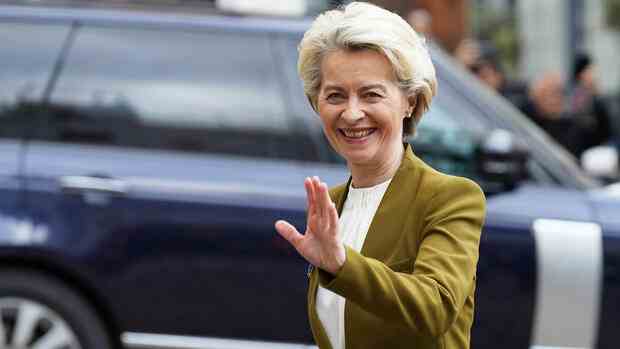The head of the EU Commission wants to promote climate-friendly technologies.
(Photo: dpa)
Berlin, Brussels In order to avoid a dangerous dependence on China, the EU Commission wants to set production targets for solar cells, wind turbines, batteries and heat pumps for the member states. By 2030, the EU should be able to produce 40 percent of its annual requirement for emission-free technologies itself, writes the EU Commission in a draft for the “Green Deal Industrial Plan”. The document is available to the Handelsblatt.
Authorities chief Ursula von der Leyen announced the proposed law in January to strengthen Europe’s position in global competition. The specifications for batteries and wind turbines are particularly ambitious: the EU is aiming for a self-sufficiency rate of 85 percent in these areas. In contrast, the Commission is satisfied with 40 percent for the production of photovoltaics – because the European solar industry has been decimated by cheap Chinese suppliers over the past ten years.
China is explicitly mentioned in the draft law. “The Union is highly dependent on concentrated imports for certain net-zero technologies and their components,” argues the Commission, citing “photovoltaic technologies and their components” from China as an example. So far, the entire European demand has been partly covered by Chinese imports.
>> Read here: Why Chinese companies are suddenly benefiting from US taxpayers’ money
When it comes to heat pumps and wind turbines, the Commission warns that Europe’s position in global competition is deteriorating.
More money from the state
The concern of falling behind in the fight for green future industries is also fueled by the US government’s subsidy offensive – the “Inflation Reduction Act”. American law is also designed to reduce dependence on China. It provides attractive tax credits and could siphon off investments from the EU, Europeans fear.
Therefore, the EU also wants to provide more generous funding in the future. There are actually narrow limits to state aid in the EU. On the contrary, the new law should now contain a provision that states should invest a minimum amount. This is to be defined as a proportion of the revenue from CO2 emissions trading.
Various member states have already spoken out against such a relaxation of state aid law because they fear a distortion of competition within Europe.
>> Read here: After the skepticism comes the boom: This is how the USA wants to conquer the hydrogen market
At the same time, the Commission is pressing for the approval process to be speeded up. Strategically important energy projects, so-called net zero resilience projects, should in future be decided across Europe within one year if the planned capacity is more than one gigawatt. The approval of projects with a lower output should even take place in eight months. The member states should therefore bundle all the necessary competencies in one authority (“one stop shop”).
In exceptional cases, regular approval procedures are even to be suspended entirely. To this end, the member states should create “sandboxing” options. Newly developed zero-emission technologies should be able to be tried out within these living laboratories without having to comply with the normal regulations. Instead, the authorities then have to monitor the individual projects more closely.
The document does mention a new financing instrument, but it has not yet been set up. Such a “sovereignty fund” should be created later, it is said.
Nuclear power on an equal footing with wind and sun
Nuclear power and carbon capture have the same standing in the bill as solar, batteries and wind power. All of these are defined as “strategic zero-emission technologies” that the law aims to accelerate. The list also includes heat pumps, geothermal energy, green hydrogen, biomethane and electricity grids.
>> Read here: A continent is stuck – How Europe loses the race for the gigafactories
In the past there was often a dispute about the distinction between nuclear power and CO2 capture. Both technologies are significantly more climate-friendly than the previous burning of coal and gas. However, the large-scale capture and storage of CO2 has not yet been tested, which is why there have been concerns about it for a long time, especially in Germany. In the case of nuclear power, the problem of final storage for radioactive waste has not yet been solved.
Details of the draft may change before the EU Commission presents it. This should be the case on March 14th. After that, the European Parliament and EU member states can make changes before adopting the law.
More: How Habeck wants to revive the photovoltaic industry
